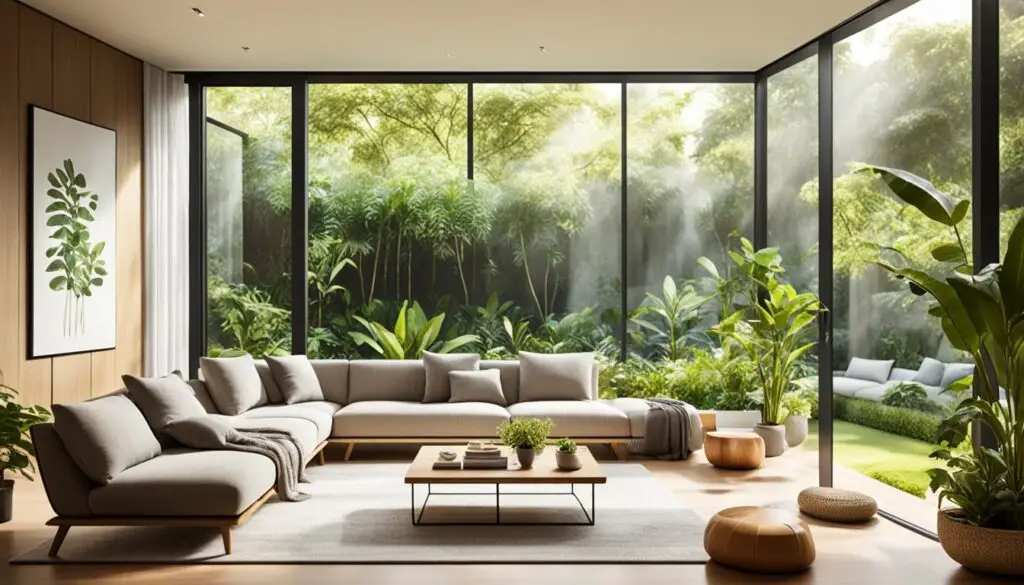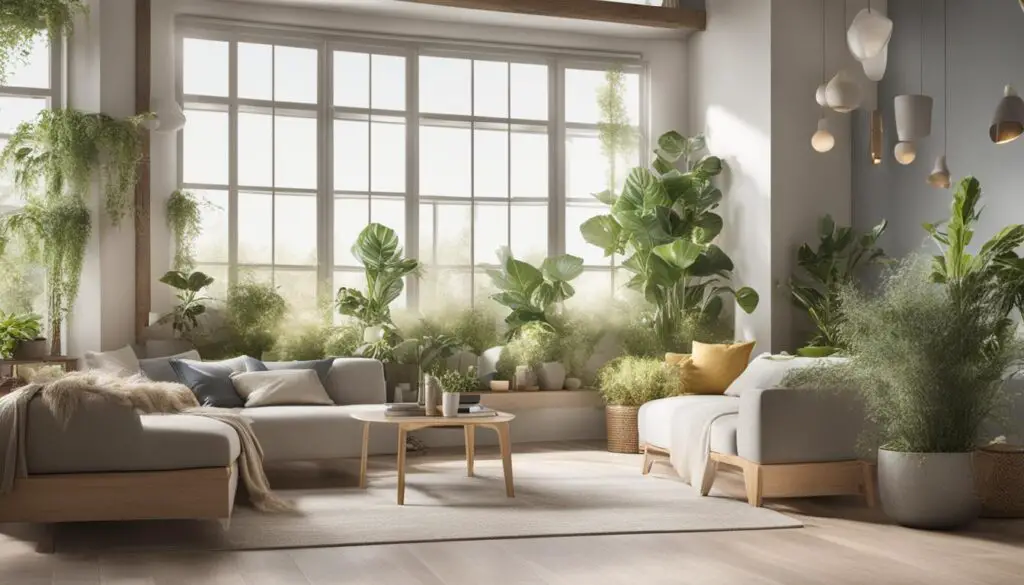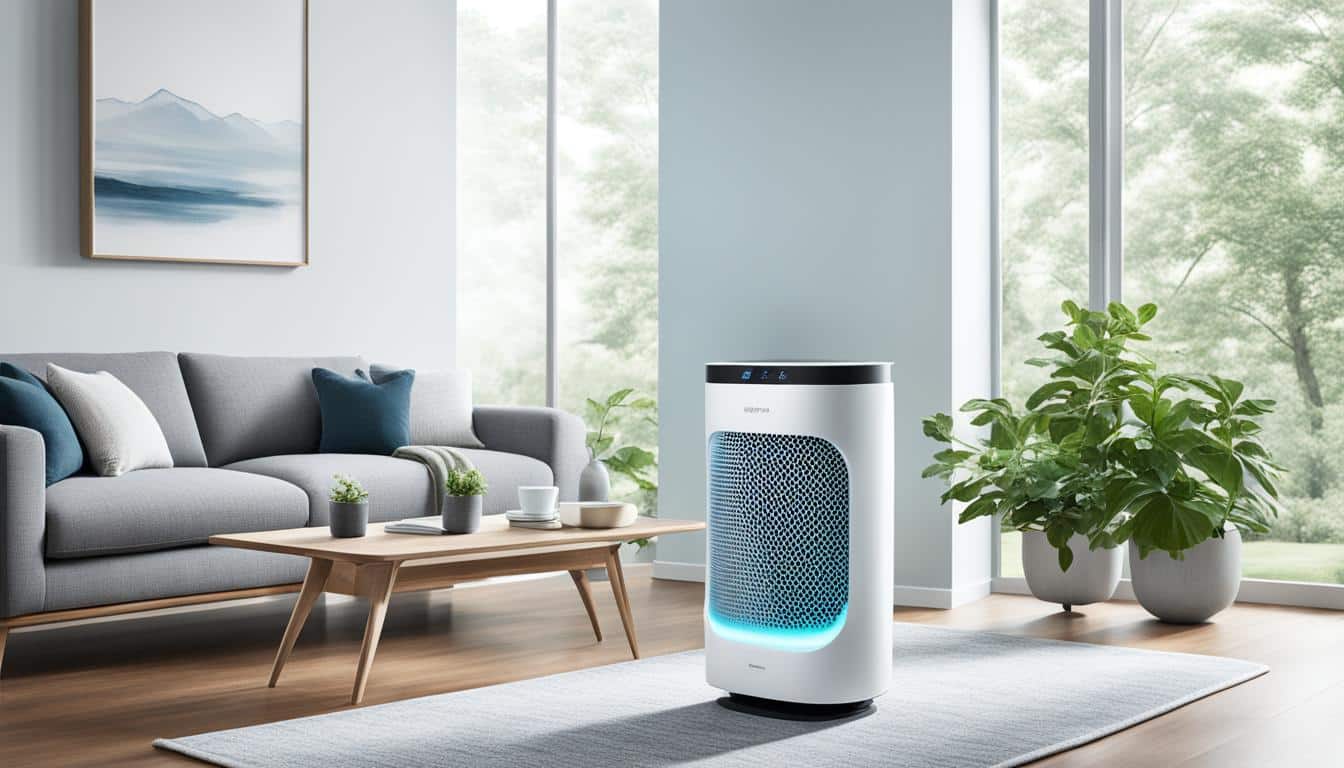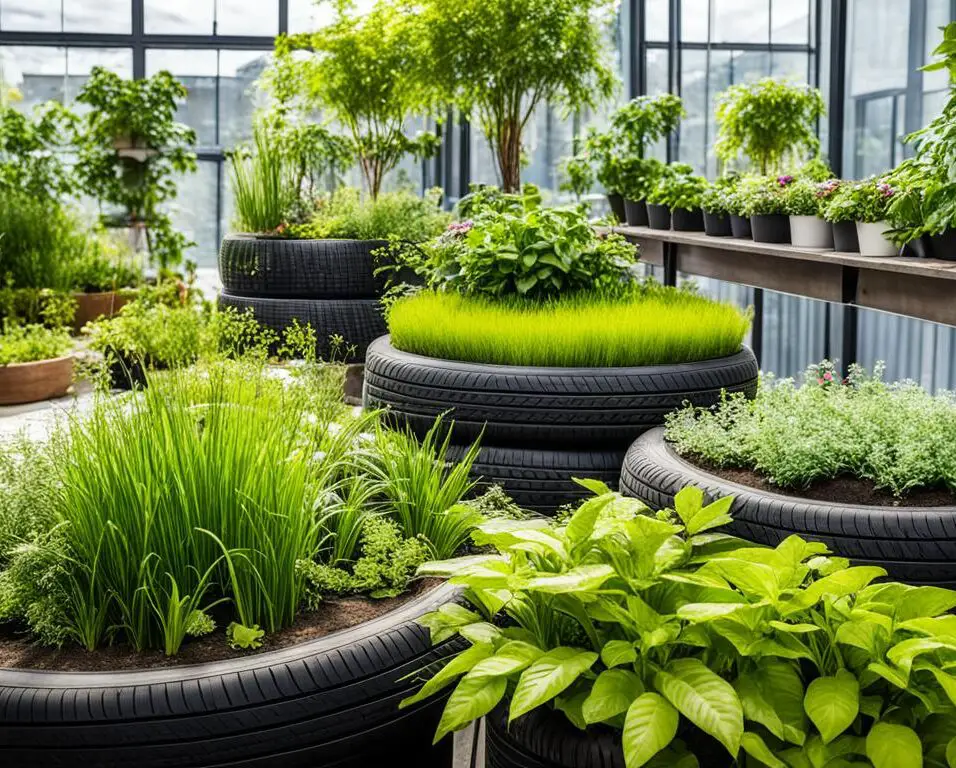Biophilic Design: Enhancing Indoor Air Quality and Allergen Reduction
Welcome to the first section of our series on biophilic design and its impact on indoor air quality. In this article, we will explore how incorporating biophilic elements into your indoor spaces can help improve air quality and reduce allergens. Additionally, we will discuss the importance of investing in a HEPA air purifier as part of an overall strategy for creating a healthier indoor environment.
Indoor air pollution is a significant concern in modern society, with combustion, particulate matter, and volatile organic compounds (VOCs) being common culprits. Poor indoor air quality can lead to various health issues, including allergies, respiratory problems, and even decreased productivity. Investing in an effective air purification system, such as a HEPA air purifier, can play a crucial role in removing airborne allergens and pollutants.
Key Takeaways
- Biophilic design incorporates natural elements into indoor spaces to improve air quality and reduce allergens.
- HEPA air purifiers are highly effective in removing airborne contaminants and improving indoor air quality.
- Indoor air pollution can have significant negative impacts on health, productivity, and overall well-being.
- Combustion, particulate matter, and VOCs are common causes of indoor air pollution.
- Investing in biophilic design and HEPA air purifiers can create optimal indoor spaces that promote well-being and reduce allergens.
Common Causes of Indoor Air Pollution and Allergens
Indoor air pollution poses a significant threat to our health and well-being. It can be caused by various factors, including particulate matter, allergens, residential combustion, and harmful gases. Understanding these common causes is essential for creating a safer and healthier indoor environment.
Particulate Matter
Particulate matter refers to tiny airborne particles that can be found indoors. These particles include dust, smoke, pollen, and other contaminants. When inhaled, they can trigger respiratory issues and worsen existing conditions such as allergies and asthma. Effective filtration systems and regular cleaning are crucial for reducing particulate matter in indoor spaces.
Allergens
Allergens such as mold, dust mites, and pet dander are common contributors to indoor air pollution. These microscopic particles can cause allergic reactions, respiratory problems, and exacerbate asthma symptoms. Maintaining a clean and hygienic environment, including regular dusting and vacuuming, can help minimize allergen exposure.
Residential Combustion
Activities such as burning fuel, smoking, or even burning candles can release harmful emissions into indoor air. These emissions contain pollutants like carbon monoxide, nitrogen dioxide, and volatile organic compounds (VOCs). Adequate ventilation and avoiding indoor smoking can significantly reduce the impact of residential combustion on indoor air quality.
Harmful Gases: Radon and Carbon Monoxide
Radon, a naturally occurring radioactive gas, can seep into homes through cracks in the foundation. Prolonged exposure to radon has been linked to lung cancer. Carbon monoxide is an odorless and colorless gas produced by fuel-burning appliances, such as furnaces and stoves. It can cause severe health issues, and in high concentrations, it can be fatal. Regular testing for radon and installing carbon monoxide detectors are essential safety measures.
“Understanding the common causes of indoor air pollution and allergens is the first step towards creating a healthier indoor environment.” – John Green, Indoor Air Quality Expert
Addressing indoor air pollution and allergens is crucial for promoting a healthier living space. By implementing effective ventilation systems, utilizing air purifiers, and adopting healthy lifestyle practices, we can minimize the impact of these pollutants and create a safer indoor environment for ourselves and our loved ones.
15 Ways to Improve Indoor Air Quality
To create a healthier indoor environment and improve air quality, there are various effective strategies you can implement. By following these 15 tips, you can ensure cleaner and fresher air in your home or office.
- Invest in a HEPA Air Purifier: HEPA (High-Efficiency Particulate Air) purifiers are designed to capture and filter out small particles, such as dust, pollen, and pet dander, improving the overall air quality. Place the air purifier in high traffic areas or rooms where you spend most of your time.
- Use Low-VOC Products: Volatile Organic Compounds (VOCs) found in many household products can contribute to indoor air pollution. Opt for low-VOC or VOC-free products, including paints, cleaning supplies, and furniture, to minimize the release of harmful chemicals into the air.
- Open Windows for Ventilation: Regularly open windows to allow fresh air to circulate, improving ventilation and reducing the concentration of indoor pollutants. This simple step can significantly enhance indoor air quality.
- Regularly Replace Air Filters: Clean and replace air filters in your HVAC system on a regular basis. Clogged or dirty filters can hinder airflow and allow pollutants to recirculate in your home. Refer to the manufacturer’s instructions for proper maintenance.
- Reduce Clutter: Clutter can trap dust and other allergens, reducing air quality. Keep your living and working spaces tidy and free from unnecessary items to minimize the accumulation of pollutants.
- Keep Humidity Levels in Check: High humidity can promote the growth of mold and mildew, which can adversely affect air quality. Use dehumidifiers in damp areas and ensure adequate ventilation in bathrooms and kitchens to prevent excessive moisture buildup.
- Avoid Smoking Indoors: Smoking indoors releases a multitude of harmful chemicals into the air, diminishing indoor air quality and posing serious health risks. Create a smoke-free environment by enforcing a no-smoking policy indoors.
- Properly Clean and Maintain HVAC Systems: Regularly clean and maintain your heating, ventilation, and air conditioning (HVAC) systems to ensure optimal performance and air quality. Schedule professional inspections and cleanings at least once a year.
- Dust and Vacuum Regularly: Dust and vacuum your home or office regularly to remove accumulated dust, pet dander, and other allergens. Use a vacuum cleaner equipped with a HEPA filter for better air filtration.
- Choose Natural Cleaning Products: Opt for natural and non-toxic cleaning products to minimize the release of harmful chemicals into the air. Look for environmentally friendly alternatives or make your own DIY cleaners using safe ingredients like vinegar and baking soda.
- Keep Outdoor Pollution Out: Minimize the entry of outdoor pollutants by using doormats at entrances, removing shoes indoors, and keeping windows and doors closed during times of high pollution, such as rush hour or when there is nearby construction.
- Introduce Air-Purifying Plants: Certain indoor plants, such as aloe vera, spider plants, and peace lilies, can naturally purify the air by absorbing harmful gases and releasing oxygen. Add these air-purifying plants to your indoor spaces for a natural boost to air quality.
- Monitor Carbon Monoxide Levels: Install carbon monoxide detectors in your home to safeguard against this odorless and potentially deadly gas. Carbon monoxide is released by combustion appliances such as gas stoves, fireplaces, and furnaces.
- Choose Low-Emission Furniture: Furniture made with low-emission materials, such as solid wood or formaldehyde-free products, can help minimize the release of harmful chemicals into the air. Look for furniture brands with eco-friendly certifications.
- Avoid Synthetic Fragrances: Synthetic fragrances found in air fresheners, scented candles, and personal care products can release toxic compounds into the air. Opt for fragrance-free or naturally scented alternatives.
Implement these strategies consistently to create a healthier indoor environment and improve the air quality you breathe every day.
Comparison of Air Purifier Brands
| Brand | Key Features | Price Range | Filter Replacement Frequency | Noise Level (dB) |
|---|---|---|---|---|
| Dyson | 360° HEPA filtration, smart sensors, air quality display | $300-$700 | Every 6-12 months | 35-65 |
| Honeywell | HEPA and activated carbon filters, digital controls | $100-$300 | Every 3-5 years | 40-60 |
| Blueair | HEPA Silent technology, Wi-Fi connectivity, smartphone app | $200-$600 | Every 6-12 months | 32-56 |
The Benefits of Biophilic Design in Improving Indoor Air Quality
Biophilic design, which incorporates nature into indoor spaces, offers several benefits for improving indoor air quality. One of the key elements of biophilic design is the presence of indoor plants. These plants not only enhance the visual appeal of indoor spaces but also serve as natural air purifiers, filtering toxins and improving air quality.
Indoor plants have the remarkable ability to remove harmful pollutants from the air, such as formaldehyde, benzene, and trichloroethylene. Through the process of photosynthesis, plants absorb these toxins and release clean, oxygen-rich air. Research has shown that certain varieties of indoor plants, such as snake plants, pothos, and peace lilies, are particularly effective at purifying the air.
The presence of indoor plants can significantly improve indoor air quality by filtering out toxins and releasing clean, oxygen-rich air.
In addition to purifying the air, indoor plants also contribute to humidity regulation. Through a process called transpiration, plants release moisture vapor into the air, increasing humidity levels. This can be especially beneficial in dry indoor environments, as it helps to create a more comfortable and balanced atmosphere.
Furthermore, the presence of plants in indoor spaces has been shown to reduce stress and promote relaxation. Studies have found that being in the presence of nature or greenery can have a calming effect on the mind and body, leading to improved overall well-being. The visual appeal of greenery can create a soothing and peaceful atmosphere, enhancing the aesthetic of indoor spaces.
Key Benefits of Biophilic Design in Improving Indoor Air Quality:
- Air purifying: Indoor plants filter toxins and improve air quality.
- Humidity regulation: Plants release moisture vapor, increasing humidity levels.
- Stress reduction: The presence of plants promotes relaxation and reduces stress.
- Visual appeal: Greenery enhances the aesthetic of indoor spaces and creates a calming atmosphere.
Indoor plants not only improve air quality but also contribute to humidity regulation, stress reduction, and visual appeal in indoor spaces.

The Impact of Indoor Elements on Health and Well-being
Indoor elements play a significant role in influencing occupant health and well-being. From the materials used in construction to the overall indoor environment, these factors can have both positive and negative effects on individuals. It is crucial to consider the impact of indoor elements to create optimal indoor spaces that promote occupant comfort and productivity.
Toxic Materials and Indoor Air Quality
One key consideration is the presence of toxic materials, especially those high in volatile organic compounds (VOCs). These chemicals can be found in various products, such as paint, furniture, and cleaning supplies. When released into the air, VOCs can contribute to indoor air pollution and negatively affect respiratory health. Occupants may experience symptoms like headaches, dizziness, and allergies. Improving indoor air quality by reducing the use of toxic materials is essential for maintaining a healthy indoor environment.
The Impact on Productivity and Quality of Life
Poor indoor environments can have a detrimental effect on occupant productivity and quality of life. Uncomfortable temperatures, inadequate lighting, and poor acoustics can all contribute to decreased concentration and overall dissatisfaction. When individuals are not comfortable in their surroundings, their ability to focus and perform tasks efficiently may be compromised. By prioritizing comfort elements such as temperature control and proper lighting, occupant satisfaction and productivity can be greatly improved.
The Importance of Considered Design
Creating an optimal indoor environment requires careful consideration of various factors. The nine foundations of a healthy building, including air quality, thermal health, moisture control, and ventilation, serve as a guide for designing spaces that prioritize occupant health and well-being. By incorporating these principles into the design process, architects and interior designers can create indoor spaces that foster comfort, productivity, and overall well-being.
It is evident that the impact of indoor elements on occupant health and well-being is significant. From the avoidance of toxic materials to the prioritization of comfort elements, every decision in indoor design should be made with the goal of creating a healthier and more comfortable environment. By recognizing the importance of indoor elements, we can contribute to the creation of spaces that promote occupant health, productivity, and comfort.

Conclusion
In conclusion, prioritizing biophilic design and implementing strategies to improve indoor air quality are crucial for creating healthier and more comfortable indoor environments. By addressing common causes of indoor air pollution and utilizing techniques like HEPA air purifiers, low-VOC products, and proper ventilation, we can create optimal indoor spaces that enhance well-being and reduce allergens.
Incorporating biophilic design elements, such as indoor plants, not only enhances indoor air quality but also creates a more nature-connected environment. These plants act as natural air purifiers, filtering toxins and improving the overall quality of the air we breathe. Moreover, their presence introduces moisture vapor, regulating humidity and creating a more comfortable atmosphere.
By transforming our indoor spaces into sanctuaries of clean, natural air, we can positively impact occupant health, productivity, and comfort. The 9 foundations of a healthy building, including air quality, thermal health, moisture control, and ventilation, should be taken into consideration when designing optimal indoor spaces.
Investing in biophilic design and adopting indoor air quality improvement strategies result in a healthier indoor environment that promotes well-being. By focusing on these key elements, we can create spaces that not only meet our aesthetic desires but also contribute to our physical and mental well-being. Let’s embrace biophilic design and create optimal indoor spaces that provide a breath of fresh air for all.
FAQ
What causes indoor air pollution and allergens?
Indoor air pollution can be caused by particulate matter such as dust, smoke, and pollen, as well as allergens like mold, dust mites, and pet dander. VOCs, which are chemicals that off-gas into the air, can also contribute to indoor air pollution. Residential combustion, including burning fuel and other activities like smoking or burning candles, produces harmful emissions. Radon and carbon monoxide are additional pollutants that can impact indoor air quality and respiratory health.
How can I improve indoor air quality?
There are various ways to improve indoor air quality, including investing in a HEPA air purifier, using low-VOC products, opening windows for ventilation, and regularly replacing air filters. Other methods include reducing clutter, keeping humidity levels in check, and avoiding smoking indoors. Proper cleaning and maintenance of HVAC systems, as well as regular dusting and vacuuming, can also help improve indoor air quality.
How does biophilic design help improve indoor air quality?
Biophilic design, which incorporates nature into indoor spaces, offers several benefits for improving indoor air quality. Indoor plants act as natural air purifiers, filtering toxins and improving air quality. Plants also release moisture vapor, increasing humidity and creating a more comfortable environment. The presence of plants can reduce stress and promote relaxation, leading to better overall well-being. Additionally, the visual appeal of greenery can create a calming atmosphere and enhance the aesthetic of indoor spaces.
What is the impact of indoor elements on health and well-being?
Indoor elements can significantly impact occupant health and well-being. Toxic materials, such as those high in VOCs, can negatively affect indoor air quality and respiratory health. Poor indoor environments can lead to decreased productivity and quality of life for occupants. Comfort, including factors like temperature, lighting, and acoustics, also plays a crucial role in occupant satisfaction and overall well-being. The 9 foundations of a healthy building, including air quality, thermal health, moisture control, and ventilation, are important considerations for creating optimal indoor environments.
Why is biophilic design important for creating healthier indoor environments?
Biophilic design and other strategies for improving indoor air quality are essential for creating healthier and more comfortable indoor environments. By addressing common causes of indoor air pollution and implementing strategies such as using HEPA air purifiers, low-VOC products, and proper ventilation, it is possible to create optimal indoor spaces that promote well-being and reduce allergens. Incorporating biophilic design elements, such as indoor plants, can further enhance indoor air quality and create a more nature-connected environment. By prioritizing indoor elements and biophilic design, we can transform our indoor spaces into sanctuaries of clean, natural air.








